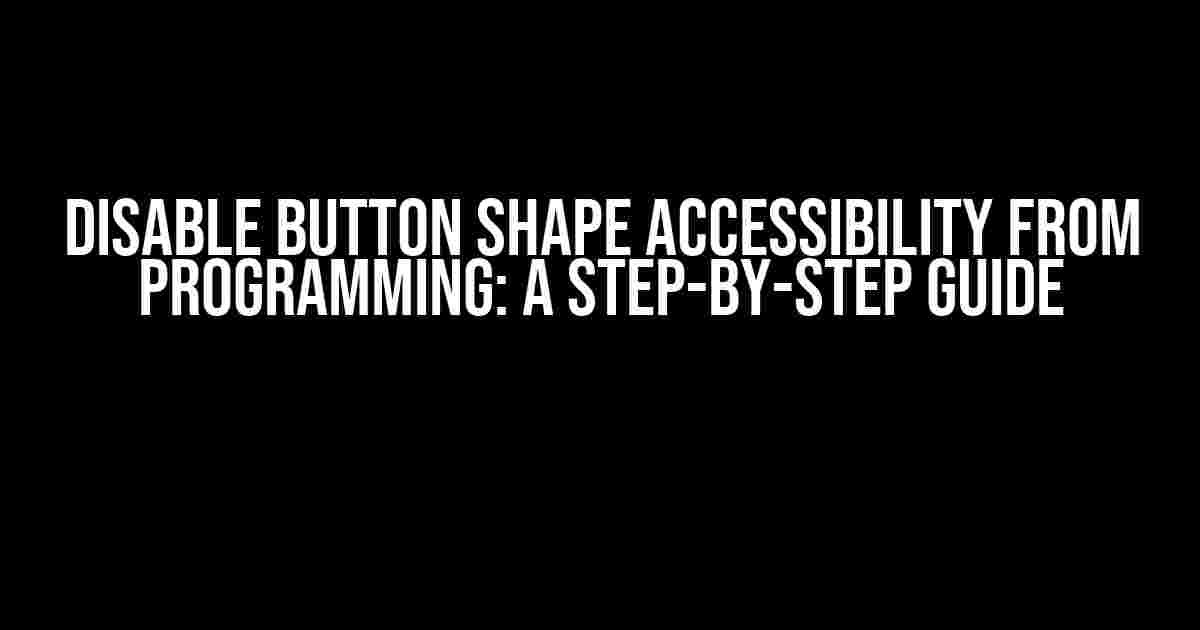Hey there, developers! Are you tired of those pesky accessibility features getting in the way of your sleek and modern UI design? Do you want to disable button shape accessibility from programming and take back control of your interface? Well, you’re in luck because today we’re going to dive into the world of accessibility and show you exactly how to do just that!
What is Button Shape Accessibility?
Before we dive into the nitty-gritty of disabling button shape accessibility, let’s take a step back and understand what it is. Button shape accessibility is a feature that allows users to customize the shape of their buttons to better suit their needs. This can be especially helpful for users with disabilities who may struggle with traditional button shapes.
However, we’re not here to discuss the merits of accessibility features (although, let’s be real, they’re super important!). We’re here to learn how to disable them. So, let’s get started!
Why Disable Button Shape Accessibility?
There are several reasons why you might want to disable button shape accessibility. Here are a few:
- Design consistency: If you’re going for a super sleek and modern design, those pesky accessibility buttons can really throw off the aesthetic. By disabling them, you can ensure a consistent design throughout your application.
- User experience: Let’s face it, some users can get a little carried away with customizing their buttons. By disabling button shape accessibility, you can ensure a consistent user experience across all devices and platforms.
- Performance optimization: Accessibility features can sometimes cause performance issues, especially in older devices. By disabling button shape accessibility, you can optimize your application’s performance and ensure it runs smoothly.
Disabling Button Shape Accessibility in HTML/CSS
Disabling button shape accessibility in HTML/CSS is relatively straightforward. Here’s an example:
<button style="appearance: none; -webkit-appearance: none;">Click me!</button>
In this example, we’re using the `appearance` and `-webkit-appearance` properties to disable the default button styling. This will give you a plain, rectangular button that’s free from any pesky accessibility features.
Disabling Button Shape Accessibility in JavaScript
Disabling button shape accessibility in JavaScript is a bit more complex. Here’s an example using vanilla JavaScript:
const button = document.querySelector('button');
button.style.appearance = 'none';
button.style.webkitAppearance = 'none';
In this example, we’re using JavaScript to select the button element and then disable the default button styling using the `appearance` and `-webkit-appearance` properties.
Disabling Button Shape Accessibility in React
Disabling button shape accessibility in React is a bit more involved. Here’s an example using React Hooks:
import React, { useState } from 'react';
function Button() {
const [style, setStyle] = useState({
appearance: 'none',
webkitAppearance: 'none',
});
return <button style={style}>Click me!</button>;
}
In this example, we’re using React Hooks to create a state variable that stores the button’s styles. We then use the `style` property to apply the styles to the button element.
Disabling Button Shape Accessibility in Angular
Disabling button shape accessibility in Angular is a bit more complex. Here’s an example using Angular’s built-in `styles` property:
import { Component } from '@angular/core';
@Component({
selector: 'app-button',
template: '<button [style]="style">Click me!</button>',
styles: ['button { appearance: none; -webkit-appearance: none; }']
})
export class ButtonComponent {
style = {
appearance: 'none',
webkitAppearance: 'none',
};
}
In this example, we’re using Angular’s built-in `styles` property to apply the button styles. We then use the `style` property to apply the styles to the button element.
Conclusion
And there you have it, folks! Disabling button shape accessibility from programming is a relatively straightforward process. Whether you’re using HTML/CSS, JavaScript, React, or Angular, we’ve got you covered.
Remember, accessibility features are important, but sometimes they can get in the way of our design goals. By disabling button shape accessibility, you can take back control of your interface and create a consistent, optimized user experience.
So, go ahead and give it a try! Disable those pesky accessibility features and take your UI design to the next level!
| Framework/Library | Method |
|---|---|
| HTML/CSS | 使用appearance和-webkit-appearance属性 |
| JavaScript | 使用 JavaScript select 元素并禁用默认按钮样式 |
| React | 使用 React Hooks 创建状态变量并应用样式 |
| Angular | 使用 Angular 的 styles 属性应用样式 |
Now, go forth and conquer the world of UI design (but don’t forget to keep accessibility in mind!)
Additional Resources
Want to learn more about accessibility and UI design? Check out these additional resources:
- Web Content Accessibility Guidelines (WCAG 2.1)
- Material Design Accessibility Guidelines
- Accessibility in Design Systems
That’s it for today, folks! Thanks for joining me on this journey into the world of button shape accessibility. Don’t forget to subscribe for more tutorials, guides, and UI design goodness!
Frequently Asked Question
Get the scoop on disabling button shape accessibility from programming!
Why would I want to disable button shape accessibility?
You might want to disable button shape accessibility if you’re creating a custom button design that doesn’t require the default accessibility features. Perhaps you’re building a custom UI component that already includes its own accessibility features, or maybe you just want more control over the user experience.
How do I disable button shape accessibility in HTML?
Easy peasy! You can add the `role=”presentation”` attribute to the button element to disable its native accessibility features. For example: ``. This tells the browser to treat the button as a simple presentation element, rather than an interactive control.
What are the consequences of disabling button shape accessibility?
Disabling button shape accessibility can make it harder for users with disabilities to interact with your application. Screen readers and other assistive technologies might not be able to detect the button or provide the necessary guidance, which can lead to a poor user experience. So, make sure you have a good reason for disabling accessibility features and that you’re providing alternative solutions for users who need them!
Can I disable button shape accessibility in CSS?
While you can’t directly disable button shape accessibility in CSS, you can use CSS to target the button element and remove any default styling that might be interfering with your custom design. For example, you could use `button:focus { outline: none; }` to remove the default focus outline. However, keep in mind that this won’t fully disable accessibility features, and you should still use the `role=”presentation”` attribute in your HTML to ensure proper accessibility support.
Are there any alternative solutions to disabling button shape accessibility?
Instead of disabling accessibility features, you could focus on creating a custom button design that’s accessible and inclusive from the start. This might involve using ARIA attributes to provide a clear and consistent user experience, or incorporating keyboard-navigable elements to ensure that users can interact with your application using multiple input methods. By designing with accessibility in mind, you can create a better experience for all users!



